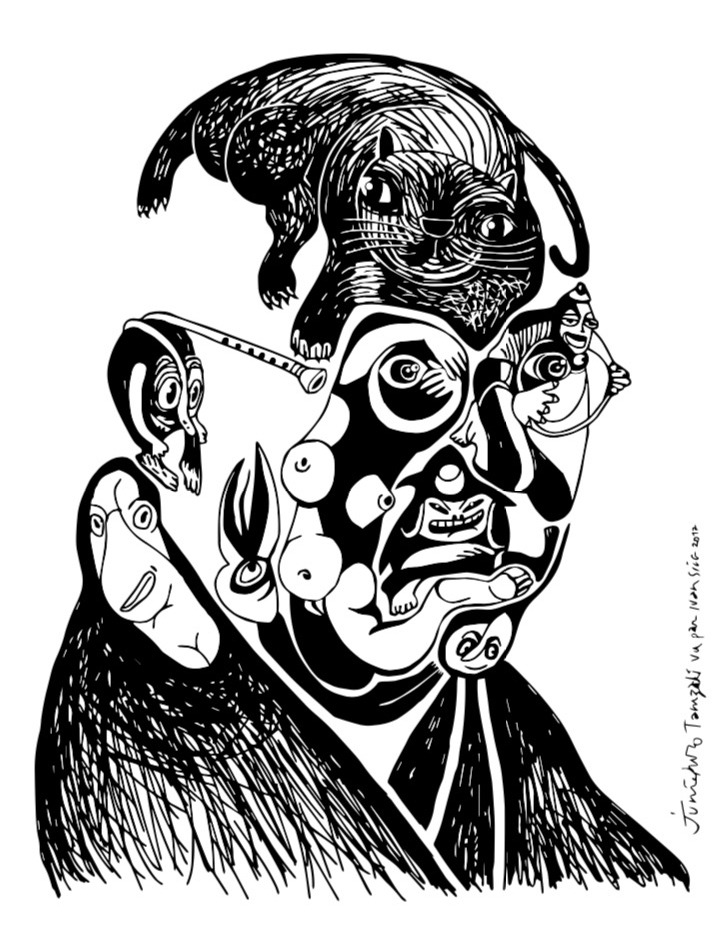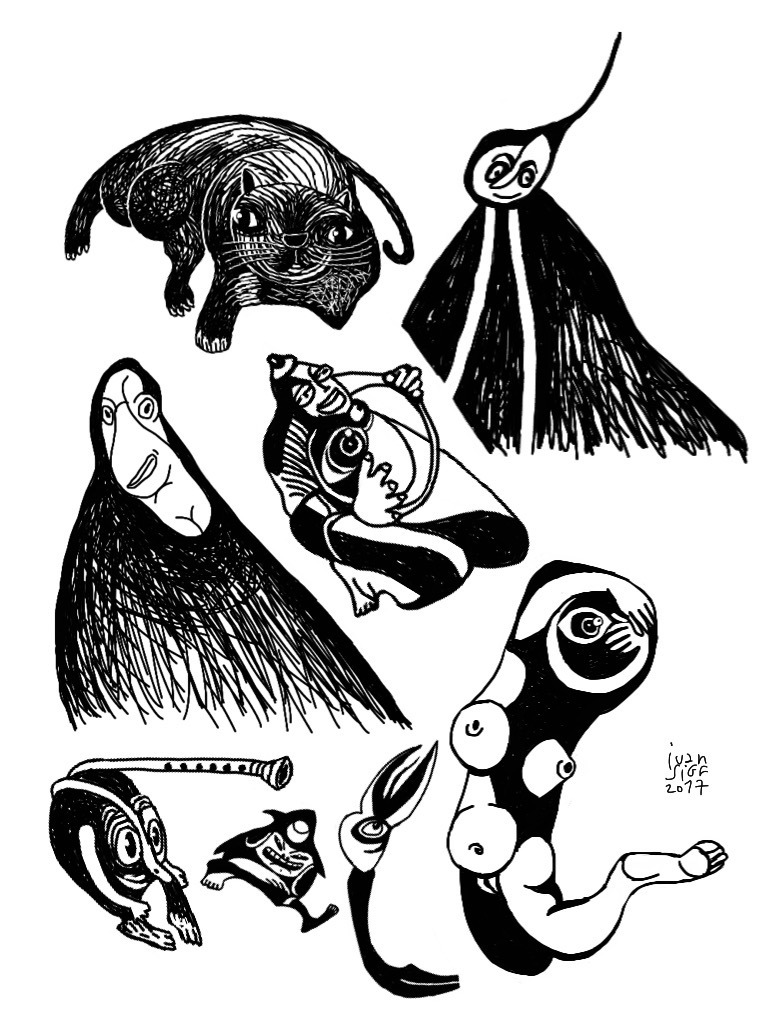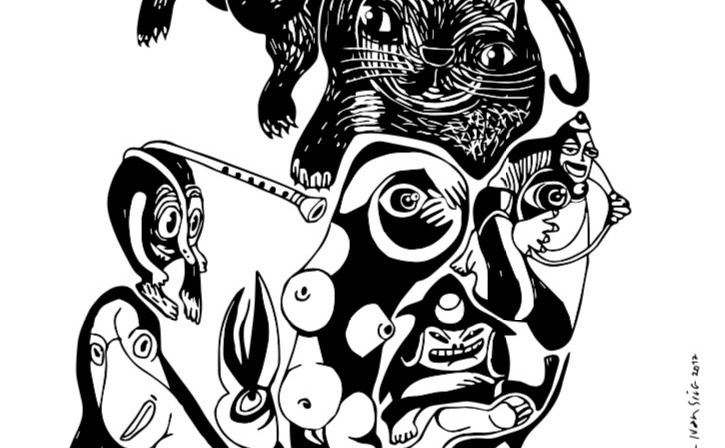Echoing the work of the philosopher and pedagogue Jiddu Krishnamurti (1895-1986)
In a clearing, in the heart of the forest: a pole, a rope and, at the end of this rope, firmly attached, a goat, terrified by the vastness of the forest and the inevitable arrival of the wolf.
This goat, it’s me, it’s you.
The pole is the center from which I think and act; it is my conditioning (my education, my life course, my culture, my knowledge, my beliefs, my memory, my prejudices, my ideals). It’s not my « being in the present » (new at all times). This pole is my « self » that governs my behavior.
The rope is what I believe to be my degree of freedom. Its length defines the limits of my consciousness and my knowledge (My consciousness is limited to its content. My knowledge is always limited).
The wolf is the other, my fears, a virus, global warming…
The forest is the world, my planet, life.
What am I afraid of? The wolf? The forest? Impossible since I have never seen them. I am afraid of what I project onto them. I can’t be afraid of what I don’t know, of what didn’t happen, of the unknown! I’m afraid because I’m attached to the past, to the known (to the pole). In fact, I fear losing the known that reassures me. This pole (and its rope) is the only solid thing (given, known) that I can count on (it is durable, fixed, it will always be there). “I would like” to detach myself from it, but unconsciously I hold on to it because it is my center. Most of the time I confuse myself with it; without its solidity I have the feeling of being very fragile, of being nothing. This rope defines a perimeter and an area of movement that I know well. The pole defines my identity. The forest, on the other hand, is an immense emptiness (or an obscure abyss) of which I do not know the limits.

Can we draw the human complexity and the internal revolution necessary for its awakening? Here is the great Japanese writer Junichirō Tanizaki. For my exhibition in his Ashiya Museum (Japan), I made his Wabi Sabi* portrait, where we see him inhabited by his desires, his characters, and his traumas.
Then, what can I do? Stretch the rope little by little? To “have more freedom”? It would only feed the illusion and the source of conflict of BECOMING: “I am this and I want to become that”. I would run a little further, but the wolf would still eat me.
Gnaw the pole or the rope? How long will it take me? The rope (very solid) and the pole (hardwood sunk very deeply) will resist! I will expend enormous energy (not creative; I will learn nothing from this relentlessness), I will exhaust myself (disrespecting the limits of my body), without necessarily obtaining results. The effort is conflict, it only shields the walls of my consciousness. Finally, my fears will only grow. Why are they going to grow? Because in my back, i.e. in my goat brain (focused on a repetitive spot, not attentive to the movement of the world, no longer making new neural connections), my interior images of forest and wolf (from my memory) will grow with my stress.
Replace pole or rope? Revolutionize them? Transform them? reform them? (this is just changing continuity). Destroy them? make a clean sweep? (it’s destroying the clearing and me with it). Ignore them? (it is to run away or to blind myself) : it is only displacement of the problem and creation of new resistances.
Only one thing to do: SEE and UNDERSTAND, here and now, the pole of my conditioning and the rope of my attachments. If I am fully attentive, without a priori, without a will and without expectation, then I really see them and they dissolve!
Understanding my goat status is like being a new goat; it is not to change my situation, it is to die to this being (to die to myself, my attachment and my fear) thus immediately be reborn new; It is emerging from conflicts that are maintained by the wish of BECOMING.
My freedom is not measured by the length of the rope, nor by the pole solidity degree.
Freedom cannot be measured! (like humility, beauty, happiness or truth)
Freedom is not an end (“one day I will be able to detach myself and I will be free”) but a means before any action.
Freedom is TO SEE the whole NOW: the pole, the rope, me, the forest and the wolf.
By freeing myself here and now from all internal and external authority, by freeing myself there now from my fears, by allowing myself freedom now, there are no more poles and no ropes that are worthy. My psychic freedom decreed frees me from all physical shackles.
By freeing myself from this center which is not my « being alive » and which scleroses me, I can then evolve in all directions, think in all directions. So there is no clearing with a bait-frightened goat on the one hand, and the forest full of fear on the other; there is not a goat watching and a forest (full of awe) observed. There is no longer any time or distance between the goat and the forest. The goat and the forest are one. The goat is the forest, and the forest is the goat. The immensity of the forest (the infinity of the present) is no longer terrifying because I am the forest, I am the other, I am the wolf, I am the world and the world is me. So there is only one state of being, always new, open to everything possible.

A very beautiful mother, a cat, a weak father, feudal Japan, Junichirō Tanizaki’s animal libido (he is a man of brothels),
his superstitions, his perversity, the weapon of writing.
TO SEE is to have no more center, no more purpose, ideal, belief, prejudice, or fear. TO SEE is to understand in the present, in the moment. Understanding is a surge, a fire that does not smoke and leaves no ash (no trace in the psyche, no injury, no repression). There is then no more choice and I understand perfectly, as a goat, what I must do (it is not a reaction but an action): which path to take (respect myself, respect others, benevolence, develop and share my skills, sobriety, decrease, recycling, mutualization…), to avoid the wolf or to go to him (confront him without fear and control him if necessary), find my food, find my way, find shelter (the essentials) and especially how to stop me getting attached or being tied by others. But for that I must be totally attentive (no expectation, no judgment, no rejection, no identification, no fight) to the pole, the rope, the forest, the wolf, the trees, the rivers, the oceans, the sky, and to earth, because they are my life equation with many unknowns.
Being fully attentive is nothing but LOVING, that is to say: giving without waiting for a return.
How to be a fully attentive goat?
Realizing that I don’t know anything; accepting my fundamental solitude; looking at myself in the mirror of the relationship with others; sharing what I see (inside and outside) with all the other goats who are attached to their reassuring post.
What if I meet a free goat that has neither pole nor rope?
The radiance of his detachment (if I am attentive to it) will have on me the effect of an internal explosion which will allow me to be reborn new to myself.
* Wabi Sabi is a Japanese concept.
Wabi: solitude, simplicity, melancholy, nature, sadness, asymmetry.
Sabi: weathering over time, decay of aging things, patina of objects,
taste for old things, for soiling.

Ivan Sigg is a French painter and novelist, joyful like an unconscious goat, who decrees his freedom and tries - through irony, observation, know-how, to cut the rope of identification with Tanizaki sensei (authority).
Email: atelierivansigg@gmail.com
Youtube channel: Ivan Sigg
Website: ivan-sigg.com
The MAHB Blog is a venture of the Millennium Alliance for Humanity and the Biosphere. Questions should be directed to joan@mahbonline.org.
This article is part of the MAHB Arts Community‘s “More About the Arts and the Anthropocene”. If you are an artist interested in sharing your thoughts and artwork, as it relates to the topic, please send a message to Michele Guieu, Eco-Artist and MAHB Arts Community coordinator: michele@mahbonline.org. Thank you. ~

